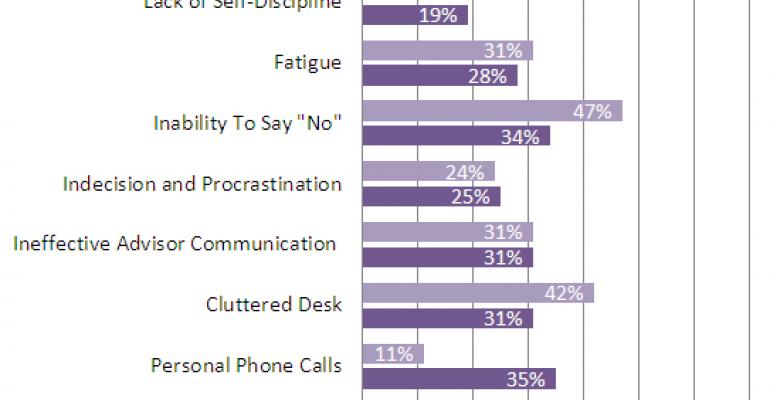Phoenix: “We recognize the importance of continually improving our service model,” Robert said. “But there are only so many hours in a day, and we can’t afford to be continually hiring new support personnel to meet the service expectations of our affluent clients.”
I couldn’t agree more. No advisor will achieve “service nirvana” by constantly hiring more personnel. In fact, it’s been our experience, in more than two decades of coaching teams and dealing with virtually every aspect of practice management, that a number of issues must be addressed before considering any new hire. In this issue, I’m going to discuss one of the more insidious of these pre-hire issues—existing time wasters.
It might be helpful if I put all of this into the context of affluent client loyalty. Every 21st-century financial practice wants their clients to be loyal, especially their affluent clients. In our 2011 Q1 affluent research project, we asked affluent investors: “What would cause you to search for another financial advisor?” Two responses trumped all others and were a virtual tie for Number One:
- Poor service.
- Repeated mistakes.
As I’ve written about repeatedly, this financial crisis has placed financial advisors into a new world where the advisor/client relationship has forever changed. The amount of services today’s affluent investor is expecting to receive, combined with the level of personal service they are demanding, highlights the importance of best-of-class support personnel. This component of a financial practice has become indispensable.
Financial advisors who recognize the importance of this component and are willing to invest the time, energy and money into developing excellence within the role will find themselves reaping the rewards of the positive word-of-mouth influence generated by their affluent clients. With just a little fine-tuning, most financial advisors are capable of making significant improvement in this critical area without spending a lot of money. The first step in such fine-tuning is to correct any existing time wasters.
To help you along in this process, I thought it would be helpful to review the Time Waster section of our 2011 Q1 Administrative Assistant Survey. Please take notice of the differences in perception between advisors and assistants in virtually every category. This is the heart of the issue.

The above graph outlines the major administrative assistant “time wasters” from the perspective of both the advisor and the assistant, all of which interfere with providing personal service and eliminating mistakes. But this also highlights a serious performance reality: many advisors don’t really know what their personal administrative assistant is doing throughout the course of a day. Whether it’s advisors complaining of their assistant’s inability to prioritize, or servicing smaller clients, or cluttered desks, existing time wasters will not be corrected until advisors and assistants get on the same page.
The following five-step exercise will help you find any existing time wasters hampering your team. This is a delicate exercise. You don’t want your assistant to think his/her job is in jeopardy (unless it is). Let them know you’ll be running the same exercise personally to see what areas eat into your productive time as well:
1. Ask your support staff to rate him or herself in each of these categories in the above graph using the following five-point scale (1 = not a time waster, 2 = not a serious time waster, 3 = could use improvement, 4 = a time waster, 5 = a serious time waster) for your support person.
2. Independent of your support staff, each advisor also rates each of these categories.
3. Meet as a team to discuss your rating of each category.
4. Agree on an action plan to correct the top three serious time wasters that everyone agrees upon.
5. Reconvene in 30 days to determine the progress. If serious time wasters are corrected, repeat step 3 for all remaining time wasters.
Improvement in service begins with advisors knowing what their assistant is doing during their working day. When this occurs, a natural clarification of roles and responsibilities follows, as well as improved communication between advisors and support personnel.
Today’s environment has created a tremendous opportunity for advisors to differentiate themselves through their personalized service and solutions. The days of viewing support personnel as an automatic solution to service issues, only to be treated as an after-thought once hired, are long gone. I recognize none of this is easy, but eliminating existing time wasters doesn’t cost any money, it will help improve your service model, and will keep you from making a hasty or unnecessary hire (which could cost you dearly).
If you would like a FREE copy of an excerpt from our Administrative Assistant Survey, as well as FREE access to three of our recent webinars, visit our download center by clicking here. Enjoy!
Also, if you haven’t already - join The Oechsli Institute’s Group on LinkedIn!
Once again, we want to thank all of you who have e-mailed comments and questions to us. We will continue to do our best to answer each one.
If you have any topic suggestions or special requests, please contact Rich Santos, publisher of Registered Rep. and Trusts & Estates magazines, at [email protected].





